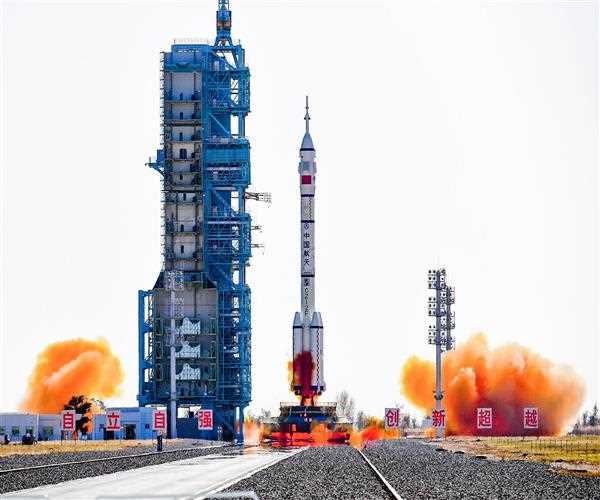
03-May-2024 , Updated on 5/3/2024 11:53:32 PM
China just launched its most complex robotic lunar mission
China has made a great stride in its space exploration sector with the successful flight of the Chang'e-6 mission, their most technologically advanced robot mission to the moon thus far the country's National Space Agency declared that the start was an achievement.
The purpose of such a mission is to become a milestone within a development strategy of China which pretends to be a respectable power in space in future; it plans to land astronauts on the moon by 2030 and build a research base on its south pole. This notable occasion reveals the increasing capability of Chinese space technology and its desire to reach the level of the space exploration industry's leading player.
Historic Launch from Hainan
On a sunny Friday, Chang'e-6 was put into orbit using the Long March-5 rocket from the Wenchang Space Launch Center which is part of Hainan Island. The contest turned out attended by a great number of people and was viewed as an important milestone for China's space history. The National Space Administration announced that the mission which would occur during the next 53 days was successful, marking the beginning of a highly anticipated moon's far side mission.
Mission Objectives
Chang'e-6 will represent the debut of the lunar far side which is impossible to directly observe from the ground affected by the long-term uninvestigated phenomenon. Its purpose is to gather approximately 2 kilograms of lunar rocks and soil in particular so that scientists can gain a deeper understanding of moon' composition and of the solar system's evolutionary history.
The mission includes several components: will have an orbiter, a lander, an ascender, and a returning module which will each carry out very significant tasks in the mission. At the end of the mission, the spacecraft will land near south pole of the Moon at the edge of Salous-Thotien basin, believed to be more than 4 billion years old and collects the samples that the ascender will later carry to the orbiter and return to the earth. Lastly is the reentry module which shall bring all the soil samples to the Earth.
Technological Marvels and Challenges
The effect of communicating from the near side of the moon though becomes tough as although direct communication with the earth is impossible to hold. However, for this, the Chang'e-6 is dependent on the superposition of Queqiao-2, which was sent to the Moon orbit earlier this year, to retransmit signals to Earth.
This mission aims to accomplish the success of Chang'e-4, which made the lunar far side's first landing in 2019 and Chang'e-5, which transported for the first time ever near side lunar samples to Earth in 2020.
Wide-Ranging Outcomes from Space Exploration
The Chang'e-6 mission does not only signify the achievement of our aspiration but also saying that many other more in-depth missions will come after it. Since the Chinese government has laid out plans to send a crew soon to the moon and, later, set up a scientific station on the moon’s South pole. As the Chang'e-6 mission returns huge amounts of data, we will be able to use this information in further missions and the efforts demanding a sustainable lunar base.
China's Presence in the global space competitions
Space technology progress of China at an incredibly fast pace proves that the People’s Republic of China could soon be at the par of the United States and Russia which have, so far, been the traditional space powers. The Chang'e-6 endeavor thus serves as a clear evidence that China is a leading lunar explorer, a role that become more straightforward as more nations revitalizes their lunar programs in the attempt of revealing unknown scientific truths and to exploit the moon's potential resource.
International Collaboration and Competition
Not only bearing a message of international cooperation through the provision of probes belonging to France, Italy, Pakistan and the European Space Agency, Chang'e-6 is also an expression of friendly relations between humanity and countries. This cooperation lays the groundwork for development of international ties thus increasing the scientific gains resulting from the mission.
At the same time, the mission runs a rising geopolitical competition in space mostly with the US which predicts to push for bigger share of space and as inevitable threat. Such actions can be seen as one of the reasons why the USA had to push their moon project forward, in the light of China’s presence in the area. Moon race is not only for scientific purposes but has geopolitical interests too because lunar command might gain political as well as strategic power.
Conclusion
The Lunar Chang'e-6 mission is the first on the agenda of China's lunar exploration effort. The selection of the far side of the moon in China's plan demonstrates its evident traversing strength and keenness in space exploration due to mysterious and promising attributes of that area. Throughout the mission, it is going to reveal new things about the moon and show us the universe a bit clearer, which might be the beginning of the new future in space that we’ve been waiting for, mainly because of the partnership the countries will likely have in this mission.

Student
An MBA in finance imparts and improves management aptitude, inventive ability, critical thinking ability, and so forth. It offers a real-time experience that fabricates a staunch career foundation for students and working professionals. It helps them to thoroughly understand the financial sector.
Join Our Newsletter
Subscribe to our newsletter to receive emails about new views posts, releases and updates.
Copyright 2010 - 2025 MindStick Software Pvt. Ltd. All Rights Reserved Privacy Policy | Terms & Conditions | Cookie Policy